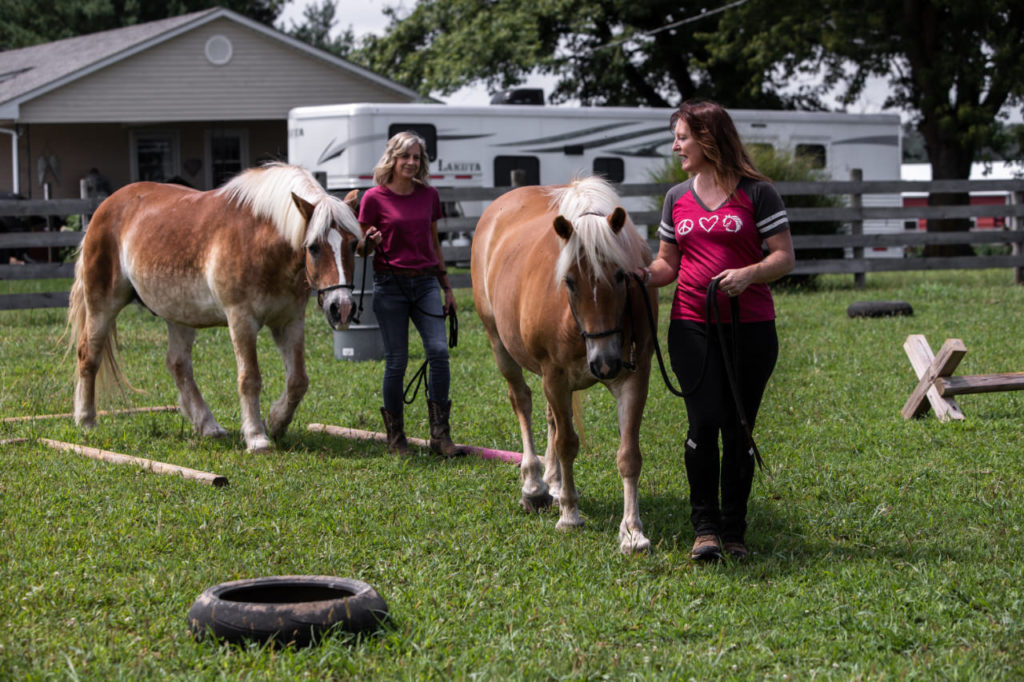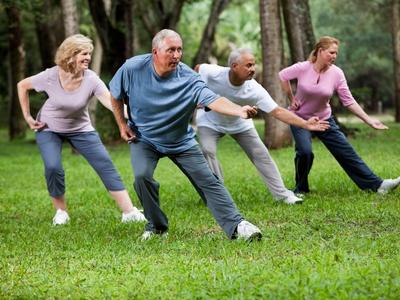After enjoying a delicious meal, we may be tempted to kick back and relax. However, emerging research suggests incorporating a brisk walk into your post-meal routine can offer numerous health benefits. From improved digestion to better blood sugar control, the advantages of walking after eating are backed by scientific evidence!
Enhanced Digestion:
One of the primary benefits of walking after eating is improved digestion. Physical activity helps stimulate the digestive system, encouraging the efficient breakdown of food. A study published in the "Journal of Gastrointestinal and Liver Diseases" found that post-meal walks accelerated the rate at which food moved through the stomach and intestines, reducing feelings of bloating and discomfort.1
Blood Sugar Regulation:
Walking after a meal may contribute to better blood sugar control, especially for individuals with or at risk of type 2 diabetes. A study in the "Diabetes Care" journal demonstrated that a short, 15-minute walk after each meal significantly lowered post-meal blood sugar levels in individuals with type 2 diabetes.2
Weight Management:
Incorporating walking into your post-meal routine may contribute to weight management. A study published in the "Journal of Physical Activity and Health" found that individuals who engaged in post-meal walks experienced reduced blood triglyceride levels, which are associated with improved metabolism and weight control.3
Mental Well-being:
Physical activity, including walking, has been linked to improved mood and reduced stress levels. Taking a short stroll after a meal can help combat feelings of lethargy and promote a sense of well-being. A review in the "British Journal of Sports Medicine" highlights the positive impact of physical activity on mental health.4

Sometimes, walking may not be an option, and that’s ok! The subtle strength of any low-impact exercise offers wonderful benefits and is accessible to individuals of all ages and fitness levels. Low-impact exercises such as using a rebounder or simply bouncing in place for 2 minutes can offer similar physical and mental health benefits!
The evidence supporting the benefits of walking after eating is compelling. From aiding digestion and regulating blood sugar to contributing to weight management and mental well-being, taking a post-meal stroll or even bouncing in place is a simple yet effective way to enhance overall health!
Incorporating this habit into your daily routine may lead to long-term positive outcomes, making it a small step with significant health rewards.
Sources
As we come into the darker part of winter and the days approach their shortest lengths, many people struggle with their mood. Sometimes called Seasonal Affective Disorder it can range from mild to severe. In addition, the holidays can be a difficult time for many people—especially when dealing with loss, isolation, or inability to connect with family and friends. There are options for getting through this time with greater ease and well-being.
From a Chinese Medicine perspective, this time of year calls for a natural slowing and drawing inward: a time for nurturing, quiet contemplation and taking a break from the tendency to strive for more.
From this perspective, the desire to slow down and reflect is not pathological but a natural reflection of the seasonal changes. This time is important to consolidate and prepare for the coming growth of spring. It’s ok to not always be striving and pushing. However, it should not be a depressing struggle. If you struggle with this time of year here are some recommendations to navigate the shorter days with better ease:

*Disclosure: I only recommend products I would use myself and all opinions expressed here are our own. This post may contain affiliate links that at no additional cost to you, I may earn a small commission. Read the full privacy policy here.
Congratulations!
You've survived another holiday season, one of the coldest storms on record for early winter, and probably even spent a little time thinking about the year to come. Millions of people have finished up their year making resolutions to do better in some way—sleep more, eat better, lose weight, save more money, or whatever they feel they are missing. Millions more have celebrated a year come and gone with only a resolution to make no resolutions. No matter which camp you fall into, resolutions often fail. Not because they aren’t worthy, or because their crafter is weak-willed, but because resolutions by themselves are not enough to create changes in habits. And little changes can add up.
We've recently started carrying a new weight loss supplement—I’m very excited about it, especially for those who get stuck in “leptin resistance” and can’t lose weight. But by itself, it's not a magic pill. It takes sustainable change to reduce weight and improve your health. As an experiment, I just added the supplement and made no other changes. I have 20 lbs I’d like to lose. It’s not horrible, but I made a choice last year to focus on other things and not worry about the weight. This year I decided it comes off. So I’ve been taking the supplement for 6 weeks with no other changes and I’ve lost about 3 lbs and 7 inches in total body measurements (waist, neck, chest, hips, arms, thighs, and calves) with the bulk coming off the waist and hips so far. I notice I’m less hungry and I’m craving more veggies with it.
I’ve also been reviewing the research of what’s out there as far as nutrition, inflammation, and weight loss. The data on fasting periodically and its ability to help your body renew itself is remarkable. I’ve looked at the research cited by the China Study, Dr. Gundry (who’s all about eliminating lectins from the diet), and Dr. Anderson (who’s all about how to regulate mental health with diet and exercise whenever possible). The trends are clear and consistent with what I already knew with some new twists. Even moderate calorie restriction for a few days a month can mimic the benefits of traditional fasting. Sugar is bad, fake sugar (with a few exceptions) is worse. Fruits are ok in moderation and when in season. Grains and starches are often just sugars in disguise! And a little quality meat can be beneficial but too much is not good either—many keto diets are far too meat heavy to be healthy in the long run.
I learned some other new things—not eating for at least 4 hours before sleep and waiting for a solid 18 hours to eat again a day or two a week can dramatically improve the housekeeping processes of the brain, leading to reduced inflammation. While I don’t know that I subscribe to the idea that lectins are disastrous for everyone, I have to admit there are enough case studies and examples that suggest if you haven't tried eating lectin-free for 30 days and you struggle with chronic inflammation of any kind, you should give it a shot. In many cases, if you give the gut adequate time to heal, you can add some of those lectin-containing foods back in moderation.

I firmly believe most people in the US are dangerously deficient in vegetables, both in quantity and variety. Many things you “don’t like” are reflections of which bacteria dominate your gut microbiome and as you change your food, you change your flora and your tastes will reflect those changes.
So, for the next 90 days, I’m going to follow the Longevity Paradox meal plan from Dr. Gundry along with my weight loss supplement. I do plan to have occasional sourdough bread in small amounts because I've tried being completely gluten-free in the past and my body feels worse with none. But there’s a huge difference between an occasional small slice of sourdough from organic non-GMO grains and the typical loaf of bread or biscuit available in stores. But other than that small variation, I plan to follow his plan closely. And I'll see what the scale says then.
If you would like to try that weight loss supplement—it’s available for order here
*Note there is both a straight retail option and a membership option for a discount—either way, it comes with a 60-day money-back guarantee!
So back to those resolutions...and why so many fail.
Goals that are not measured typically are not achieved—take for example:
“I want to exercise more in 2023”. This alone is a resolution doomed to failure!
What kind of exercise? When? How often? For how long? Let’s say you decide you want to complete a 10k run by the end of the year. That’s slightly better but still highly likely to fail unless you are already consistently running close to that distance regularly. But let’s assume like many well-intentioned resolutions, you aren't sure you can run around the block...how do you successfully turn that resolution into a completed goal?
1. Pick an actual goal date—Find a race or set a date to run that distance on your own and work backward and make sure it’s far enough out for you to have adequate time to reach your goal.
2. Break it down—If, for example, you want to run a 10k by November, you probably should be able to run a 5k by June...there are a bunch of “Couch to 5k” running guides out there—find one to help you plan.
3. Break it down again—If you want to run 5k by June, you probably should be close to 2.5k by March. That’s a reasonable time length to build a plan around.
4. Make your 90-day plan—Work back from 5k to 2.5k to 0k—and write it out. Then pick one thing you can do today to get you started. Perhaps it’s seeking advice on where to run, reaching out to a local running club, or getting outside to do a test run of how far you can go without straining right now.
5. This is most important—every day when you complete that “mini goal”—celebrate! Give yourself a high five, bask in your awesomeness; give your brain a little “dopamine rush” and help it see the benefit of completing these goals.
That's just one example—maybe your exercise goal is to maintain your current good habits. Then you might say “I will continue to lift weights for 45 min 3 days per week and get over 10K steps a day at least 5 days a week”. Or maybe your goal is to get up out of a chair without struggling— break down how to make that goal work for you!

Sometimes we know all these tricks and we still somehow “get in our own way” and as a result, don’t achieve our goals. When that happens, coaching can be immensely valuable in addressing the hidden things that are holding us back from the life we want. Depending on your needs, I may recommend working with one of the coaches I know; or in some cases working with myself and my equine partners in an equine gestalt session over at Rowdy Cowgirl Coaching.
New Year's resolutions are a great way to set goals and work towards self-improvement. While it can be challenging to stick to resolutions, it is important to remember that progress, not perfection, is the key to success. Don't be too hard on yourself if you struggle to meet your goals, and remember to celebrate your victories along the way. With determination and the right strategies, you can make lasting positive changes in your life in the new year and beyond!
Football Season is underway and did you know many top players keep themselves at peak performance with acupuncture?
This recent article quotes one of my instructors, Matt Callison, LAc—an internationally recognized expert in acupuncture & cupping for sports medicine, on the benefits of acupuncture and cupping not just for injury recovery, but for prevention as well. His style of acupuncture is heavily influenced by a deep understanding of trigger points and muscle physiology.
I attempted to produce a complete list of teams who use acupuncture, but after talking to some of the acupuncturists who work with these elite athletes, many consider acupuncture to be their “secret weapon” and don’t advertise who they work with for fear of another team or player “luring” them away!

One of these fabulous acupuncturists is Lisa Ripi who manages a grueling schedule to care for players on 4 different teams! She uses Japanese-style acupuncture which is similar to what I was trained in. Dan Domingues, LAc is another one of those gems—he shares his role as the team acupuncturist for the Buffalo Bills.
Cupping is often a big part of these treatments—even National Geographic took notice in 2018 when James Harrison (then with the New England Patriots) shared his use of cupping and acupuncture. So odds are, your favorite teams probably have acupuncture and cupping in their arsenal as tools to recover quickly and be ready for the next game!
Did you know our own Robert Cecil, LAc has extensive training in Master Tung points (great for recovery from injury), and cupping (fabulous for both recovery from muscle strain and other injuries)? In fact, just one session of cupping can increase the range of motion of the treated muscle groups in athletes—and alongside other techniques, can greatly reduce recovery time after an injury.
Acupuncture and cupping in combination with Frequency Specific Microcurrent treatments can target specific types of injured tissue to speed healing. So, regardless of if you are out on the field or cheering on your favorite players—remember we can help improve your performance!
Follow Raja Wellness on Facebook and Instagram!
Follow Raja Goods on Instagram!
A frequent question we get in the clinic is “Can you get me off my diabetes medicine?" The simple answer is “no”. Acupuncture and herbs alone are potent allies in healing, but especially with diabetes, the choices you make each day have far more impact than anything anyone can give you. The more complete answer is “it depends”:
It is also important to know that we cannot make changes to prescription medications, so it’s important to work with your doctor as well as your acupuncturist when you decide that you are ready to make the changes you need for better health.
So why try acupuncture and TCM for diabetes?
Acupuncture and herbal medicine are not a “one-size fits all” treatment approach—each patient is unique and we chose our specific formulas and acupuncture points for each patient based on the presentation of the entire patient; not just a set cookie-cutter treatment. As a result, not only do we see the diabetes symptoms improve, the patient experiences better health overall. By choosing the right approach for each patient we avoid the spiral of “take this medication for this, and this medication for that, and this medication for the side effects of the first medication and yet another medication for the side effects of the second medication….” that so many patients experience.

Now as to the pesky diet and exercise thing:
If you continue to overload your body with too much of the wrong foods and not enough of the right exercise—even the best treatments and formulas, plus the medications your doctor prescribes—won’t be enough to keep the disease from progressing!
I highly recommend anyone who has diabetes or even a risk factor for diabetes (which is pretty much everyone) read “Why We Get Sick” by B. Bikman. It’s a great book based on solid research that helps you understand what happens with diabetes and more importantly, what you can do to change it. If you need help getting off the sugar, we have amazing and compassionate coaching and nutrition partners who can help you!
Follow Raja Wellness on Facebook and Instagram!
Follow Raja Goods on Instagram!
Sources:
1 Wang KX, Liang FX, Chen S, Luo ZH, Chen B, Chen ZQ, Zhang YL, Chen J, Gu XL, Zhou T, Yan P, Xu XY. Effect of electroacupuncture of "Biao-Ben" acupoints on renal function and hemorheology and eNOS level in patients with early diabetic nephropathy. Zhen Ci Yan Jiu. 2022 Jan 25;47(1):46-52. Chinese. doi: 10.13702/j.1000-0607.20210036. PMID: 35128870.
2 Wang H, Chen X, Chen C, Pan T, Li M, Yao L, Li X, Lu Q, Wang H, Wang Z. Electroacupuncture at Lower He-Sea and Front-Mu Acupoints Ameliorates Insulin Resistance in Type 2 Diabetes Mellitus by Regulating the Intestinal Flora and Gut Barrier. Diabetes Metab Syndr Obes. 2022 Jul 30;15:2265-2276. doi: 10.2147/DMSO.S374843. PMID: 35936053; PMCID: PMC9348137.
3 Dimitrova A, Murchison C, Oken B. Acupuncture for the Treatment of Peripheral Neuropathy: A Systematic Review and Meta-Analysis. J Altern Complement Med. 2017 Mar;23(3):164-179. doi: 10.1089/acm.2016.0155. Epub 2017 Jan 23. PMID: 28112552; PMCID: PMC5359694.
If you’ve spent any time around the Raja offices, you’ve probably met “Lowkey”—the sweet German Shepherd who helps me in so many ways; it won’t come as a surprise that pets are family around our house. But did you know that the animals who share our space provide more than just companionship? Animals have innate abilities to sense and communicate when we don’t feel well (there are loads of stories with dogs, cats, and other animals alerting their owners to impending seizures, heart attacks, and more!) Many times people think I can read minds—because I come to check on them when they are having a difficult time during treatment at just the right time—but the truth is quite often that adorable dog of mine has woken from a dead sleep to alert me to the issue. I don’t know how he knows and I’m ok with him keeping the secret, as long as he keeps helping me help others!

In addition, having pets is linked to reduced rates of depression and anxiety—so much so that emotional support animals are now widely accepted. Even the CDC says “Regular walking or playing with pets can decrease blood pressure, cholesterol levels, and triglyceride levels.”1 Other studies have shown how having pets reduces cortisol levels. Furthermore, those pets of ours keep us more active and give us a reason to go outside and more even when the weather isn’t perfect.

I am blessed to work with a variety of animals who share their healing gifts with others—from our herd of horses and mini donkey to our dogs, and even the barn cats work their magic to help bring smiles to those who visit. Horses in particular can regulate the coherence of our heart rhythm and stress response just by being near us. The Heart Math Institute has some fascinating research on this. Cats have a unique “superpower” in their purr. “A cat purrs within a range of 20-140 Hz which is known to be medically therapeutic for illnesses in humans. A cat's purr can not only lower stress it can also help labored breathing, lower blood pressure, help heal infections, and even heal bones.”2
Animals of all kinds can bring joy into our lives, even the slithery and skittering kinds like snakes & lizards. They may not be for everyone (let’s face it—not everyone is a cat or dog lover), but if they brighten your day then that’s all that matters.
Jenny-Marie Greenough
As responsible human stewards of our animal friends, it’s important to remember that their health comes with unique concerns based on nutritional, environmental, and mental needs. Luckily for our horses, dogs & cats, there are a variety of supplements and herbal medicines to help keep them feeling their best! Some of my favorite products are:
For those of you with dogs—we’ve got a photo contest running to win a goodie basket for your best bud! So bring out the photos and let’s see those smiling furry faces!
Follow Raja Wellness on Facebook and Instagram!
Follow Raja Goods on Instagram!
Sources:
1 https://www.cdc.gov/healthypets/keeping-pets-and-people-healthy/how.html
2 https://www.akcreunite.org/catsimprovementalhealth/
We are excited to announce our Tai Chi Classes are back!!! These classes will be taught by Grand Master Mingye Ding and Jenny-Marie Greenough, LAc.
Why Tai Chi? Tai Chi is a practice rooted in martial arts that teaches balance, relaxation, and mindfulness. Numerous studies have shown the health benefits of Tai Chi. In fact, Harvard Medical School wrote an entire book on the subject detailing the research findings and benefits of a regular tai chi practice. The only other practice that has been shown to slow signs of physical and mental aging, reduce the risk of falling, and increase general wellness as much is dancing! That’s right—not running, not golf, not swimming or cycling or weights…dance and Tai Chi are two of the best things you can do for your long-term health. And in many ways, Tai Chi is a dance—challenging us to be more fluid, rhythmic, and powerful in our movements.
Most studies on Tai Chi have been done using Yang-style Tai Chi, the most commonly practiced here in the US, but the benefits transcend the various Tai Chi forms. Grand Master Ding can teach Yang-style, but he is world famous for his mastery of Chen-style Tai Chi—in fact, he was featured on a stamp in China for his contribution to martial arts! Chen-style adds a dynamic of hip movements and alternating very slow movements with faster movements throughout the forms. There are several other styles of tai chi he may bring into our class as well as basic tai chi warm-up movements that are different from the typical “gym” warm-ups most of us are familiar with. Some days, we may practice a more healing-focused form of Tai Chi called Qigong as part of our warm-up for the form.

These forms can be adapted to all levels of ability—from seated-forms to gentle standing to dynamic and physically challenging, that will give even the most agile of athletes something to improve on! Each of the basic forms have associated sword forms, fan forms, and various ways to take the practice to new levels of understanding!
That is the beauty of Tai Chi—no matter where you start, there is a place to begin and a goal to pursue! I was so proud when I learned my first version of the Chen forms, so imagine my shock when Master Ding said “Good job, now we begin again!”; and we did, from the very first step, with a more nuanced exploration of each movement. Over the years we have begun again and again with the form—each time there is something to learn and I can’t wait to share this with all of you!
Follow Raja Wellness on Facebook and Instagram!
Follow Raja Goods on Instagram!
Perhaps you have tried out the local yoga studio down the street. Chances are it was a “faster flow” class—it created inner heat and maybe you broke a sweat. If you have never taken a yoga class before, you might have noticed the many types out there to choose from. Ranging in all types from fundamentals all the way to an “Ashtanga” style.
No need to be intimidated—because there is a class for everyone's body and needs. Have you thought about a slower “restorative-style” yoga class? This is slower-paced class with mindful meditation, gentle music, and the time to be introspective. It gives you space to feel your body—as it is, and all it can be. Yin yoga can offer this type of movement for you. The gentle pace and meditation can be a great start or end to your day.
You can do a warm-up to start your Yin practice, but many times you will find what you experience is known as working on “cold muscles”. To make it simple, cold muscles are short and warm muscles are long. Holding these poses allows you to lengthen ligaments along with gaining a greater range of motion in the joint. Going deep into a stretch—making it sensational might be a normal feeling in your everyday yoga flow, but in Yin—slow and steady wins the race!

Allowing the time in a pose and listening to your body when it says it's ready to go deeper is great for reaching the fascia and connective tissues, not to mention the pressure points for stimulating certain areas of your body. Yin yoga poses also tend to correlate with the acupressure points and the chakra system. Stimulating these points can not only help relieve stress and calm the mind but help your body's natural flow of energy by releasing blockages. Working with your body's meridians and chakras can hold many benefits, which in turn can help with your body's natural healing.
Taking the time to hold these poses and create stillness in your life will not only help your nervous system calm down and reset but give you time to look inside and take an introspective moment for yourself—Helping you sort out thoughts and feelings and process events. Yoga in itself can be emotionally revealing, lifting, and healing with the awareness and time you create for yourself.
Along with this self-care, please remember that with any activity it is very important to stay hydrated. Especially after a good Yin yoga class, due to the nature of movement and how comparative it is to a deep tissue massage, and the toxins that are released and become ready to leave your body.
Create your healing space! Take time for yourself and remember to love yourself.
Visit our classes page, where you can browse many different yoga class styles and levels. Our yoga classes are designed for all—from beginner to advanced!
Follow Raja Wellness on Facebook and Instagram!
Follow Raja Goods on Instagram!
Getting our kids to eat healthily doesn’t have to be a nightmarish challenge. You don’t have to be a chef to make delicious meals the family will enjoy; you don’t have to be a master negotiator either. Getting our families to eat more healthily often starts with what is most readily available in the home and our own habits and attitudes when it comes to food. Children often mimic us caregivers—so leading by example can be very effective (for all of us!).
Here are a few tips and reminders to help instill those healthy habits—easily!

These changes may need to be done gradually, and it may take some time for everyone to adjust. If the habits have been in place for a while, just remember to practice patience, understanding, and open dialogue, and the payoff will be huge—with better nutrition, overall health, improved energy, money, and time savings in the end. Eating healthy won’t seem like a “downer” or “punishment”; but a real treat that can be easily shared among the family—and can instill healthy habits that can last a lifetime.